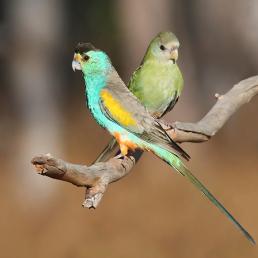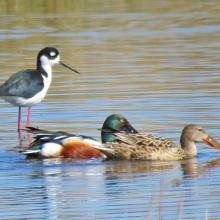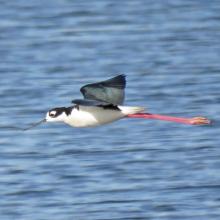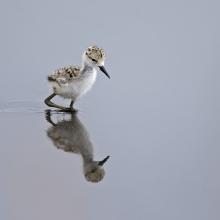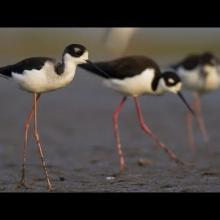

Join BirdNote tomorrow, November 30th!
Illustrator David Sibley and actor H. Jon Benjamin will face off in the bird illustration battle of the century during BirdNote's Year-end Celebration and Auction!
Visit a shallow wetland in summer, and you might see this slender, black-and-white shorebird with outrageous red legs. The Black-necked Stilt uses its long legs for wading as it feeds on tiny insects and crustaceans on the surface of the water. Stilts are sensitive to drought, which has increased with global climate change. But they readily move to new breeding areas and respond quickly when new wetlands are created.
BirdNote®
The Bird with Outrageous Legs
Written by Dennis Paulson
This is BirdNote!
[Black-necked Stilt calls]
Visit a shallow wetland in summer, and you may be dive-bombed by a slender black and white shorebird with outrageous red legs. The appropriately named Black-necked Stilt has the longest legs relative to its size of any North American bird. It uses those legs for wading, as it picks tiny insects and crustaceans from the water surface with its long, slender bill.
[Black-necked Stilt calls]
If the stilt continues to pester you, you must be near its nest. These birds signal the approach of any potential predator. They leap into the air and call with an intensity and volume all out of proportion to their delicate appearance. The persistent calling signals that the predator has been seen and often sends it on its way. Thus, the stilt’s noise and activity benefit all the birds in the vicinity.
[Black-necked Stilt]
Because of this, Black-necked Stilts are called sentinel birds. When avocets, which breed in the same habitats, add their voices to the clamor, you can understand why no sensible predator would stick around.
[American Avocet calls]
Birds of shallow wetlands, stilts are very sensitive to drought, which has increased with global climate change. But they readily move to new breeding areas, responding quickly when new wetlands are created.
[Wetland soundscape with calls of Black-necked Stilt]
To see a photograph of those outrageous red legs and learn what’s being done to conserve wetlands, come to our website, birdnote.org.
###
Bird sounds provided by The Macaulay Library at the Cornell Lab of Ornithology, Ithaca, New York. Calls of Black-necked Stilt [135386] recorded by M.J. Andersen; calls of American Avocet [2963] recorded by A.A. Allen. ambient wetland drawn from [107551] recorded by D.S. Herr.
BirdNote’s theme music was composed and played by Nancy Rumbel and John Kessler.
Producer: John Kessler
Executive Producer: Chris Peterson
© 2016 Tune In to Nature.org March 2014/2018/2022 Narrator: Mary McCann
ID# BNST-01-2014-03-24 BNST-01
